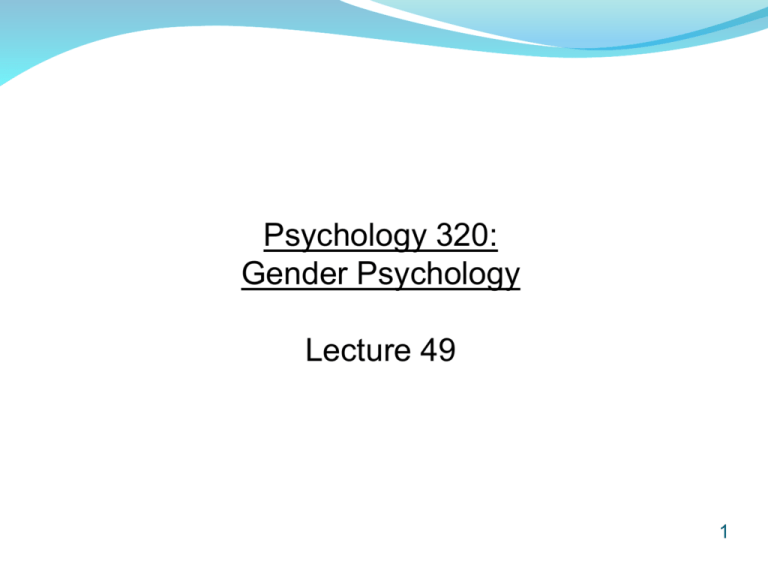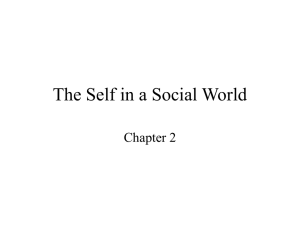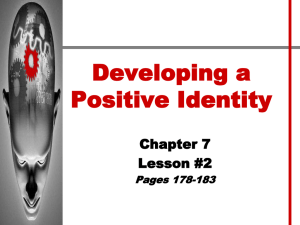
Psychology 320:
Gender Psychology
Lecture 49
1
Achievement:
1. Do males and females make different attributions for
success and failure? (continued)
2. Are there sex differences in self-esteem?
2
Do males and females make different attributions for
success and failure? (continued)
Mezulis et al., 2004
Conducted a meta-analysis of 266 papers published
between 1994-2001. The papers reported 523
effect sizes, obtained from research involving
41,438 participants. Examined the influence of sex
and age on the attributional bias. Found that:
3
(a) among young children, females were more
likely than males to display the attributional bias.
(b) among early adolescents, there was no sex
difference in the tendency to display the
attributional bias.
(c) among older adolescents and adults, males
were more likely than females to display the
attributional bias.
(d) changes across time reflected variations in
females’ attributional tendencies rather than males’
attributional tendencies.
4
Are there sex differences in self-esteem?
• Self-esteem: Global feelings of self-worth.
• Among the most widely used measures of self-esteem
is Rosenberg’s Self-Esteem Scale:
5
Rosenberg’s Self-Esteem Scale
Using the scale below, please indicate how much you disagree or agree with
the following statements. Circle the appropriate number to the right of each
statement.
1
Strongly
disagree
2
Disagree
3
Neutral
4
Agree
5
Strongly
agree
On the whole I am satisfied with myself ………………………. 1…….. 2 …
At times I think that I am no good at all ………………………..1…….. 2 ...
I feel that I have a number of good qualities …………………. 1……... 2 …
I am able to do things as well as most other people…………. 1……... 2 …
I feel I do not have much to be proud of ……………………… 1……... 2 …
I certainly feel useless at times …………………………………1……... 2 …
I feel that I am a person of worth, at least the equal of
others ………………………………………………………. 1……... 2 …
I wish I could have more respect for myself ………………….. 1……... 2 …
All in all, I am inclined to feel that I am a failure……………….1……... 2 …
I take a positive attitude toward myself ……………………….. 1……... 2 …
6
• Using the Rosenberg Self-Esteem Scale and other
measures of self-esteem, studies have revealed a
relatively small but consistent sex difference in selfesteem, with males reporting higher levels than
females.
7
Kling, 1999
Conducted a meta-analysis of 184 papers published
between 1987-1995. The papers reported 216
effect sizes, obtained from research involving
97,121 participants. Examined the influence of sex
and age on self-esteem. Found that:
(a) the overall effect size for self-esteem was .21.
(b) the effect size varied across age groups, with
the most marked sex difference occurring in late
adolescence.
8
Graphic Representation of
a .21 Effect Size (Kling, 1999)
9
Effect Size for Self-Esteem as a
Function of Age (Kling, 1999)
Age
Effect Size for
Self-Esteem
7-10
.16
11-14
.23
15-18
.33
19-22
.18
23-59
.10
> 60
-.03
10
Effect Size for Self-Esteem in Diverse
Countries (Kling, 1999)
Age
Effect Size for
Self-Esteem
Australia
.24
Canada
.24
Norway
.24
United States
.17
Miscellaneous
.31
11
Achievement:
1. Do males and females make different attributions for
success and failure? (continued)
2. Are there sex differences in self-esteem?
12






